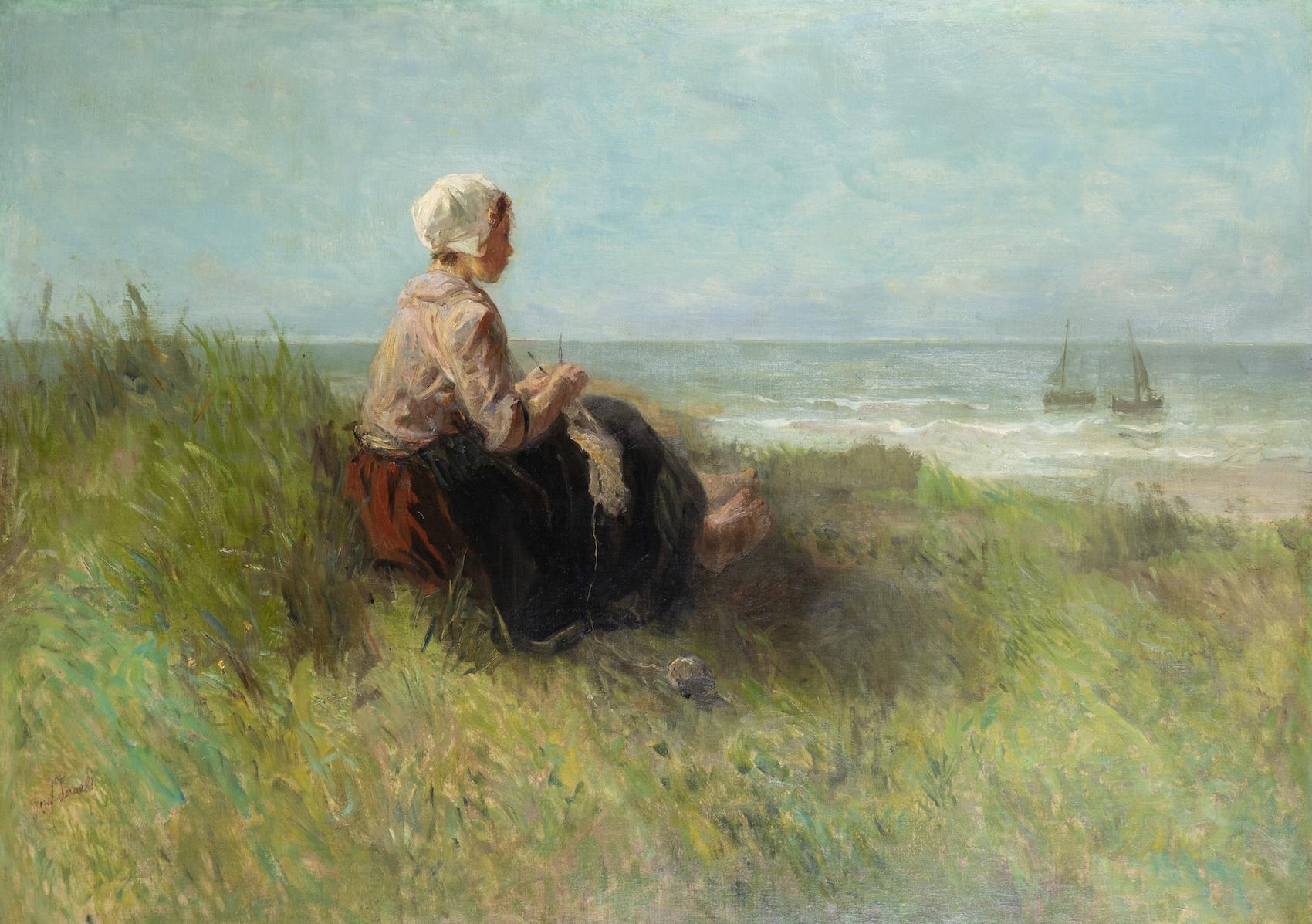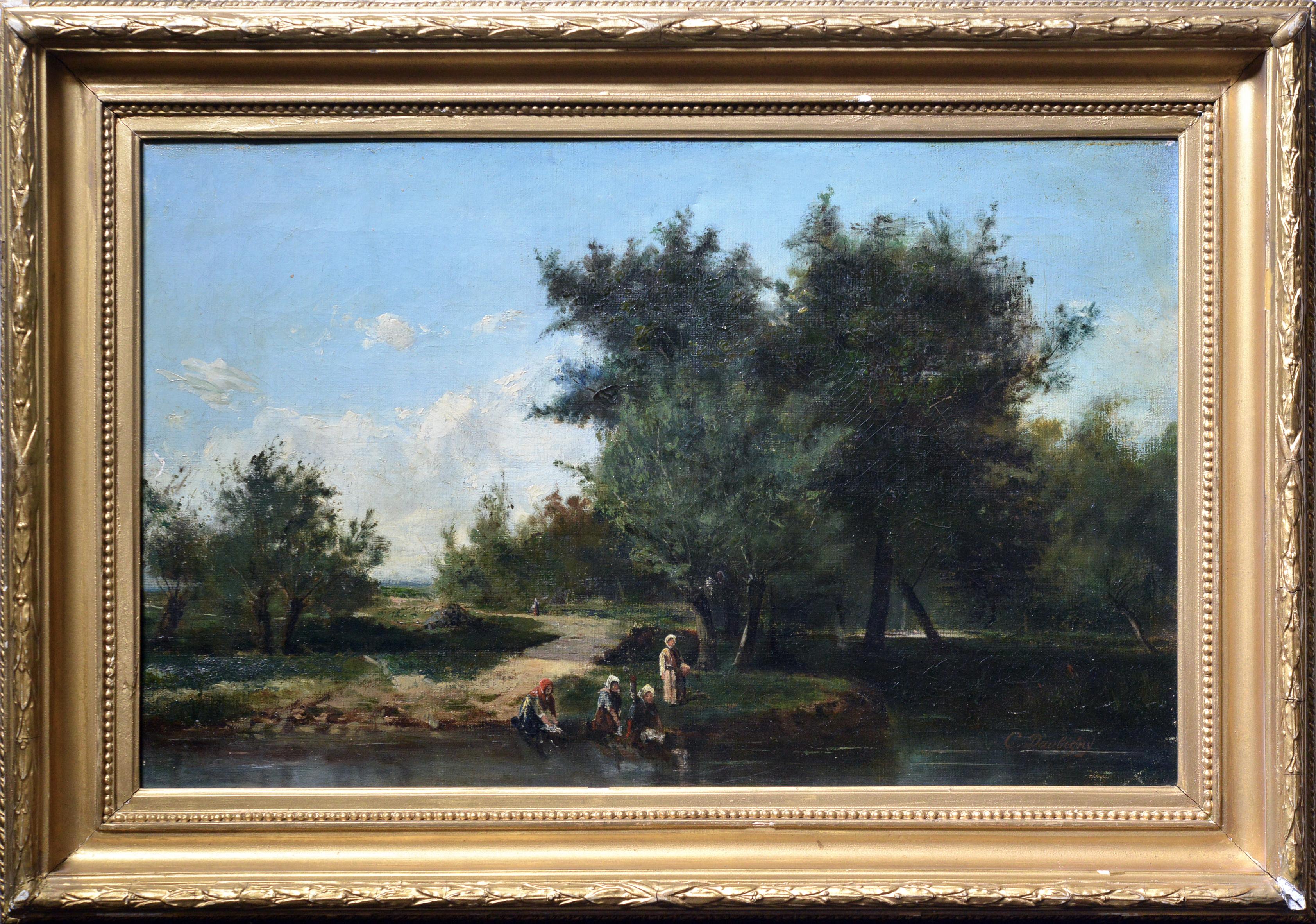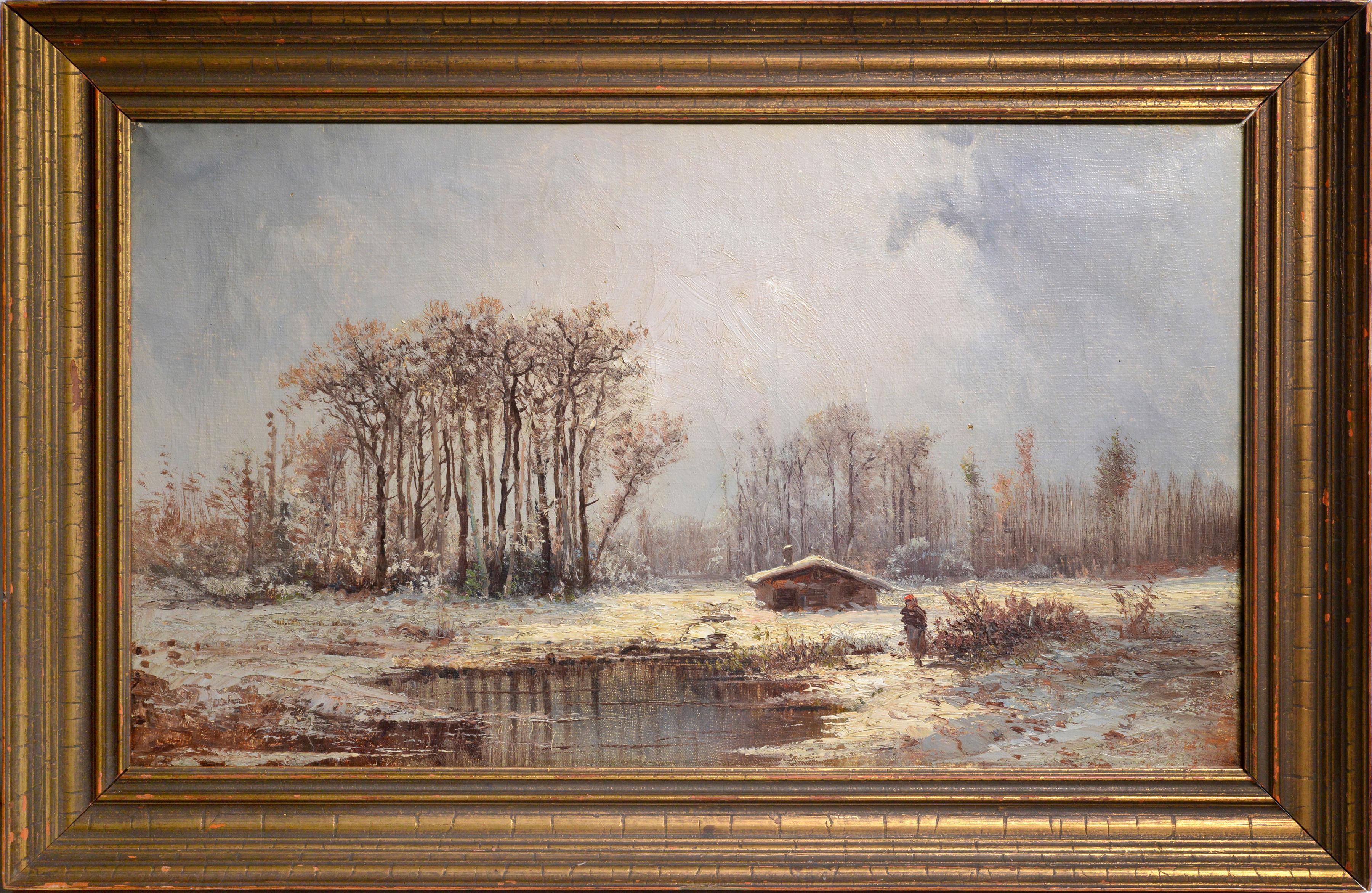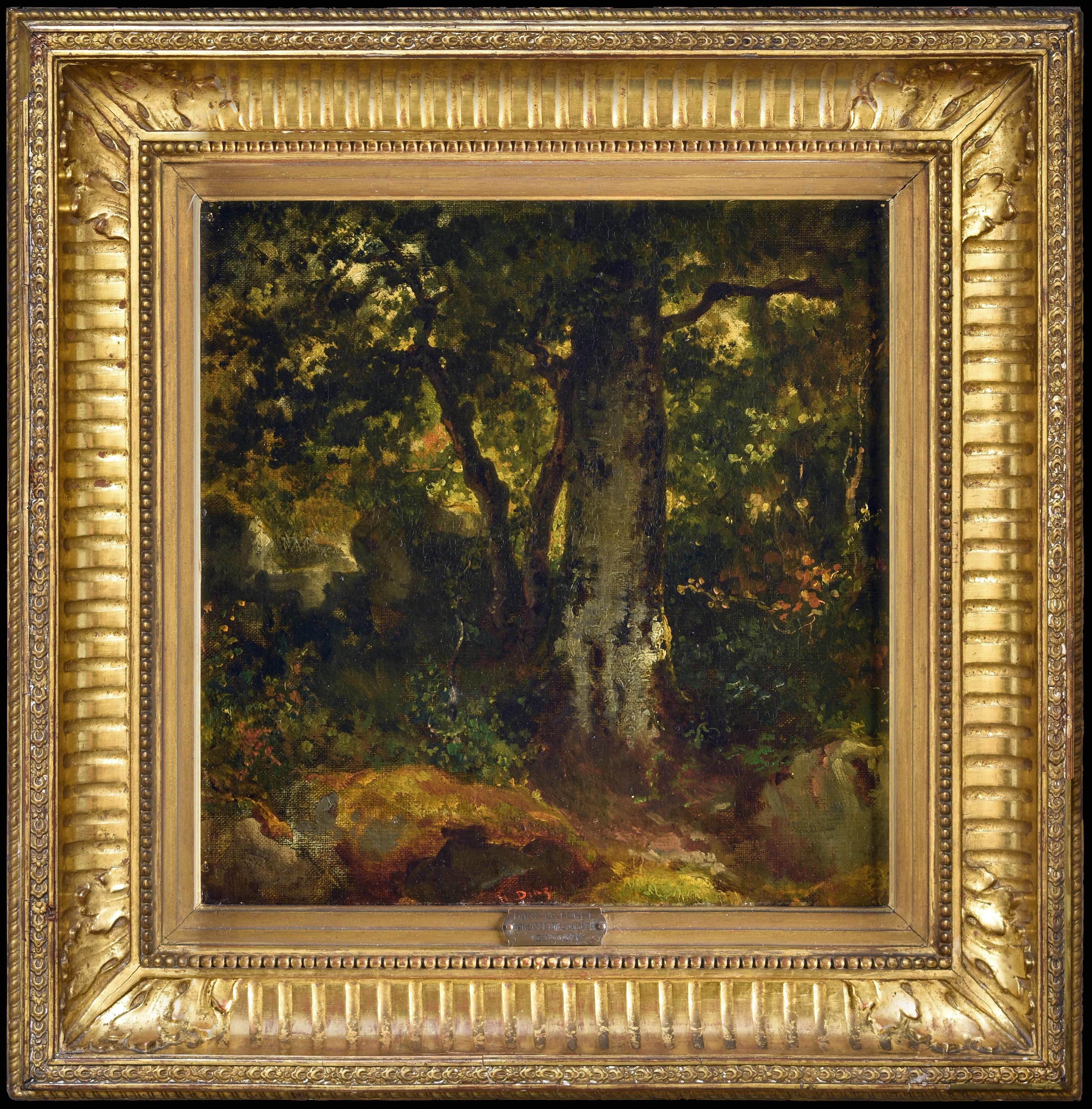Items Similar to Le repos des le moissonneurs - Barbizon Figurative Pastel by Leon Lhermitte
Want more images or videos?
Request additional images or videos from the seller
1 of 18
Léon Augustin LhermitteLe repos des le moissonneurs - Barbizon Figurative Pastel by Leon Lhermittec.1885
c.1885
About the Item
Signed figures in landscape pastel on canvas circa 1885 by French Barbizon painter Leon Augustin Lhermitte. The piece depicts two children resting beside a large haystack in farmland on a bright summer's day.
Signature:
Signed lower right
Dimensions:
Framed: 24"x30"
Unframed: 16"x22"
Provenance:
Private collection - United States
Léon Augustin Lhermitte was the son of a school teacher. He painted from a very early age and settled in Paris in 1863, enrolling in the École Impériale de Dessin. His teacher was Lecocq de Boisboudran. In the early days of his career he earned a living doing illustrations for boxes of sweets and the catalogues of the cabinet-makers of the Faubourg St-Antoine, as well as publishing houses. In 1879 he went to Great Britain, to which he returned frequently. The same year he met the art dealer Paul Durant-Ruel who exhibited his works. He was one of the founders of the Société Nationale des Beaux-Arts, of which he became vice-president.
Lhermitte initially produced charcoal drawings which revealed his deep feeling for nature. His first attempt, Banks of the Marne near Alfort, caused a sensation. Following this he executed canvases, showing himself to be a fine landscape artist and a skilful draughtsman. He painted scenes from rural life almost exclusively and benefited from exceptional interest generated by the prizes awarded to the works of J. F. Millet. But although he was very much affected by the work of the painter of Angelus, he himself sought only the pictorial element and not a synthetic translation. Many other French masters of the period share his completely objective vision, for example Bastien Lepage, Roll, J. C. Cazin and Rafaelli. Like them, he put into practice very early on the technique of 'clear painting' made fashionable by the pursuit of Impressionism. But this group of artists borrowed from this method only those elements which appealed to public taste, and ignored chromatic elements. Lhermitte also paid the price for the easy success of those early days. His peasants, which found general favour with the public at the time, nowadays seem rather feeble alongside Camille Pissarro's renderings of the same subject.
However, in order to pass judgement on an artist such as Lhermitte, it is necessary to understand the era in which he worked, the era in which Realism was the only acceptable approach. It was in the atmosphere of the 'Théâtre Libre' of Antoine and the novels of Maupassant, Zola and their imitators that this type of art developed. In this context, Lhermitte is recognised as having painted the life of the peasants with great powers of objective observation and great insight into types and physiognomies. Nothing escaped his implacable eye and his bold and vigorous hand was guided by a lucid mind. The simplest elements of nature take on an air of true grandeur in his painting, despite their romantic and sentimental aspects. He is highly regarded both in France and in other countries by art lovers who look for nothing more than an attractive subject expertly painted. Among his most noteworthy works, outside those in museums, are: Les Halles, Washing the Sheep, Haymaking Time, and his large decorative panel for the Sorbonne, Claude Bernard. He illustrated A. Thieuret's Rural Life (La Vie Rustique).
He made his debut in 1864 in Paris at the Salon des Artistes Français. He subsequently took part in numerous collective exhibitions, notably the Exposition Universelle of 1900, in which he showed seven paintings, three pastels and four drawings. His early works gained him a third-place medal in 1874, a second-place medal in 1880, and the Grand Prix at the 1889 Exposition Universelle in Paris. He received a diploma of honour in Dresden in 1890 and was decorated with the Légion d'Honneur in 1884, promoted to Officier in 1884 and to Commandeur in 1911. He was elected to the Institut de France in 1905.
Museum and Gallery Holdings:
Albany (Institute of History and Art): Landscape
Amiens: Death and the Woodcutter
Boston (MFA): Soul of the Humble
Buffalo (Albright-Knox AG): Haymaking Time
Carcassonne: Harvest
Château-Thierry (Mus. Jean-de-La-Fontaine): View of Château-Thierry
Chicago (AI): Sheafing the Hay
Florence (Uffizi): Portrait of the Artist
Montreal (Learmont): Ruins of Château-Thierry
Moscow (State Tretyakov Gal.): Le Tréport; Small Courtyard in Normandy
New York (Metropolitan Mus. of Art): Grape Harvest (1884); Soul of the Humble (1905)
Paris (MAM): Jazz Quartet
Paris (Mus. d'Orsay): Harvesters' Wages
Paris (Mus. du Petit Palais): Les Halles
Rheims: Wine Press
St Louis (Washington University): Harvest (1883, oil on canvas); Haymaking Time (1891, oils on canvas, two paintings)
St-Quentin: Pardon of Ploumanac'h
Washington DC (Corcoran Gal. of Art): Family of Harvesters
- Creator:Léon Augustin Lhermitte (1844-1925, French)
- Creation Year:c.1885
- Dimensions:Height: 24 in (60.96 cm)Width: 30 in (76.2 cm)
- Medium:
- Movement & Style:
- Period:
- Condition:Very good original condition.
- Gallery Location:Marlow, GB
- Reference Number:
Léon Augustin Lhermitte
L'hermitte often travelled to Britanny, as he was fascinated by the rural life there. His
work was shown in Paris but he also had a dealer who brought his pieces to the US, Canada, and Britain. Moreover, his work also spread through commissions in illustrated magazines. Vincent Van Gogh wrote "If every month Le Monde Illustré published one of his compositions...it would be a great pleasure for me to be able to follow it. It is certain that for years I have not seen anything as beautiful as this scene by L'hermitte...I am too preoccupied by L'hermitte this evening to be able to talk of other things." Originally from north-eastern France, Léon Augustin L'hermitte moved to Paris in time to attend the Salon des Refuses in 1863, and while studying at the École des Beaux Arts he gained recognition after his show in the Paris Salon in 1874. His many awards include the French Legion of Honour (1884) and the Grand Prize at the Exposition Universelle in 1889.
About the Seller
5.0
Platinum Seller
These expertly vetted sellers are 1stDibs' most experienced sellers and are rated highest by our customers.
Established in 2001
1stDibs seller since 2016
671 sales on 1stDibs
Typical response time: 3 hours
- ShippingRetrieving quote...Ships From: Marlow, United Kingdom
- Return PolicyA return for this item may be initiated within 3 days of delivery.
More From This SellerView All
- Painting en plein air - Impressionist Figure in Landscape Oil by Charles AngrandBy Charles AngrandLocated in Marlow, BuckinghamshireSigned and dated oil on canvas by French impressionist painter Charles Theophile Angrand. This wonderful and good-sized piece depicts an artist painting "en plain air" in a beautiful...Category
1880s Impressionist Figurative Paintings
MaterialsCanvas, Oil
- Boulevard De Clichy - Post Impressionist City Landscape Painting by Albert AndreBy Albert AndreLocated in Marlow, BuckinghamshireSigned and titled figures in cityscape oil on canvas circa 1920 by post impressionist painter Albert Andre. This stunning and good-sized work depicts a view of the Boulevard de Clichy, a famous street in the city of Paris, France on what appears to be a sunny but cool day. Signature: Signed lower left and titled & dated on original label verso Dimensions: Framed: 29"x35" Unframed: 22"x28" Provenance: New York, Durand-Ruel, Exhibition of Paintings by Albert André, 1 February -18 February, 1921 He came to Paris in 1889 as an industrial designer. At the age of 23 he enrolled at the studio of William Bouguereau at the Académie Julian, where he met Ranson, Louis Valtat and the young poet and dramatist Henry Bataille, who at the time was training as a painter. He illustrated L'étang de Berre by Charles Maurras and Les Petites Alliées by Claude Farrère. He produced cartoons for tapestries...Category
1920s Post-Impressionist Landscape Paintings
MaterialsCanvas, Oil
- Barques de Peche - Post Impressionist Landscape Oil by Henri Le SidanerBy Henri Le SidanerLocated in Marlow, BuckinghamshireSigned post impressionist landscape oil on canvas by French painter Henri Le Sidaner. This stunning piece depicts two fishing boats moored in a fishing village at sunset. The last l...Category
1890s Post-Impressionist Landscape Paintings
MaterialsOil, Canvas
- Peniches sur la Seine - Impressionist Landscape Oil - Armand GuillauminBy Jean Baptiste-Armand GuillauminLocated in Marlow, BuckinghamshireSigned impressionist landscape oil on canvas by French painter Jean Baptiste Armand Guillaumin. The work depicts barges moored on the b...Category
1880s Impressionist Landscape Paintings
MaterialsCanvas, Oil
- Bord De Mer - Impressionist Coastal Landscape Oil Painting by Willy SchlobachBy Willy SchlobachLocated in Marlow, BuckinghamshireSigned and dated pointillist landscape oil on canvas by Belgian impressionist painter Willy Schlobach. The piece depicts a coastal view looking out over the dark green sea to where it meets the powder blue sky on the distant horizon, with rock formations on either side. This work was executed in 1907 - the definitive mature period for Schlobach's work. Paintings by the artist executed between 1906 and 1908 are the pinnacle of his oeuvre and show the influence and ideas of neo impressionism brought by his friend and compatriot Theo van Rysselberghe who had learnt from Signac and Seurat in Paris. Schlobach painted numerous coastal views in this period which display a free approach to pointillism with theory being displaced by a desire to create luminosity and effect. Signature: Signed lower right and dated 1907 Dimensions: Framed: 29"x33" Unframed: 20"x24" Provenance: Private French collection Further information: This work was executed in 1907 - the definitive mature period for Schlobach's work. Paintings by the artist executed between 1906 and 1908 are the pinnacle of his oeuvre and show the influence and ideas of neo impressionism brought by his friend and compatriot Theo van Rysselberghe who had learnt from Signac and Seurat in Paris. Schlobach painted numerous coastal views in this period which display a free approach to pointillism with theory being displaced by a desire to create luminosity and effect. Willy Schlobach first studied at the Academy in Brussels and then later in Ghent. At the precocious age of nineteen he was already at the forefront of painters in Belgium numbering among his close friends Emile Verhaeren and Theo van Rysselberghe whose instructive influence on him was of great significance. He was one of the founding members of the group 'Les XX' who were broadly speaking avant-garde and influenced by the Parisian developments in painting but by no means uniform in their style or approach (see also have lots 201 and 233). Octave Maus, a lawyer and critic was the driving force behind 'Les XX' but the most important painter was Theo van Rysselberghe. Van Rysselberghe had lived and worked in Paris and brought to Belgium an intimate knowledge and understanding of the Neo-Impressionist techniques of Seurat and Signac which were to be a great influence on the younger generation of Belgian painters such as Willy Finch and Willy Schlobach. In the late 1880s Schlobach responded with enthusiasm to these new ideas emanating from Paris and produced some well structured and highly organised pointillist work in which his favoured subject matter was coastal scenes. Schlobach was also influenced by the other main group within 'Les XX' which was best represented by Fernand Khnopff. As well as working in a pointillist manner he produced paintings full of symbolism and reminiscent of the Pre-Raphaelites whose work he had studied and admired on visits to England. It is, however, in the neo-impressionist or luminist work that Schlobach found greater freedom of expression away from the sometimes claustrophobic subject matter of the symbolists. On his visits to London Schlobach had been influenced not only by the Pre-Raphaelite painters but also by the work of Turner whose atmospheric and misty paintings...Category
20th Century Impressionist Landscape Paintings
MaterialsOil, Canvas
- Grosse Mer - Etretat - Impressionist Seascape Landscape Oil by Maxime MaufraBy Maxime MaufraLocated in Marlow, BuckinghamshireImpressionist oil on canvas seascape painting circa 1895 by French artist Maxime Maufra. This stunning work depicts a sailing boat on a vast ocean. The choppy water is painted in greens and blues. The white clouds rolling across the blue sky are beautifully shaded in purple tones. Signature: Signed lower left and titled on original label verso Dimensions: Framed: 22"x25" Unframed: 15"x18" Provenance: This work is included in the catalogue raisonne of Maxime Maufra under reference 284 Durand-Ruel, Paris (acquired directly from the artist on 5 April 1895) Durand-Ruel Galleries, New York (acquired from the above in 1895) Marlborough Fine Arts, Ltd., London (acquired after 1949) Dr. Renate Davis, London (acquired from the above) Lyon & Turnbull London, 28 November 2013, lot 111 (consigned by the above) Private Collection, New York (acquired from the above sale) Sotheby's New York, 15 November 2017, lot 101 (consigned by the above) Maufra spent several years in England, notably in Liverpool, with his father, who wanted him to become a tradesman. He decided to take up painting instead and returned to France in 1883, attracting the attention of Octave Mirbeau in his very first exhibition, and subsequently being noticed by Frantz Jourdain in 1894 and Fontenais in 1901. In 1886, he successfully exhibited two seascapes at the Salon, following which he visited Brittany in 1890, making the acquaintance of Gauguin and Sérusier in Pont-Aven; he collaborated with them on the decoration of the Pouldu Inn in 1894. He maintained his acquaintance with the Nabis group artists Henry Moret and Gustave Loiseau. He travelled in l'Isère, Belgium, and Algeria (1913), as well as Paris, the Ile de France, Brittany and Normandy. From 1895, the Galerie Durand-Ruel assured the success of his work. Maufra settled in Montmartre for about ten years during which he painted the old quarters of Paris, often around the church of St Séverin. He then turned to Brittany and Normandy for inspiration in keeping with a resolve to paint only from nature, his seascapes in particular finding favour. The influence of the Nabis on his work remains limited except in the 'synthetic' organisation of the composition. He was an admirer of Sisley and Pissarro, whose influence can be seen in his paintings. Maufra, like Valtat, went to some extent beyond Impressionism to become a forerunner of Fauvism in his use of colour. An important retrospective exhibition of Maufra's work, prefaced by René Domergue, was organised in Paris around 1950. In 2001, his work was represented in the exhibition Painters and the Sarthe Region ( Les Peintres et la Sarthe) held at the Musée de la Reine Bérengère (for the 19th century) and the Abbaye de l'Épau (for the 20th century) at Le Mans. In 2003, his work appeared in the group exhibition Brittany, Land of Painters ( Bretagne, Terre des Peintres) at the Musée des Beaux-Arts in Vannes. Museum and Gallery Holdings: Bergues: Seascapes Boston: Dusk in Douarnenez; Departure of Fishing Boats Buffalo: Transport Quittant Le Havre Chicago: Douarnenez the Town of Light Cholet: Flood Cincinnati (AM): The Coast, Bay of Douarnenez (Vue de Douarnenez) (painting) Helsinki: St-Guénolé Le Havre: Moonrise in Brittany Manchester: Springtime in Lavardin Montpellier: Hills of Morgat Mulhouse: Low Tide Nantes (MBA): La Prairie d'Amont (1888, oil on canvas); Pointe du Raz; Heavy Swell; The Loir Dam in Poncé (oil on canvas) Paris (Mus. d'Orsay): Brittany Landscape...Category
1890s Impressionist Landscape Paintings
MaterialsOil, Canvas
You May Also Like
- Waiting by Jozef Israëls - Landscape oil paintingBy Jozef IsraëlsLocated in London, GBWaiting by Jozef Israëls (1824-1911) Oil on canvas 95.3 x 133.9 cm (37 ½ x 52 ¾ inches) Signed lower left, Jozef Israels A monumental painting by one of...Category
19th Century Barbizon School Figurative Paintings
MaterialsCanvas, Oil
- Laundresses on River 19th century Barbizonian Landscape by French MasterLocated in Stockholm, SESigned lower right "C. Daubigny". As we gaze upon the painting, we are immediately drawn to the foreground, where a small group of women are diligently washing clothes on the banks o...Category
Mid-19th Century Barbizon School Landscape Paintings
MaterialsCanvas, Wood, Cotton Canvas, Oil
- Spanish school landscape with river oil painting SpainLocated in Barcelona, BarcelonaOil on canvas glued to board. Oil measures 25x40 cm. Frameless. Illegible signature.Category
1920s Barbizon School Landscape Paintings
MaterialsCanvas, Oil, Board
- River Cottage 1849/ Barbizon landscape heralding Impressionism Jongkind's friendBy Henri SieuracLocated in Norwich, GBA wonderful view of a river landscape with a rustic cottage and pollarded trees by Henri Sieurac. It isa rare, early and very fresh landscape by this Parisian artist which may well have been painted in the countryside around Barbizon, near the river Loing. Henry Sieurac had studied with his father, François Joseph Sieurac , and of Paul Delaroche...Category
1840s Barbizon School Landscape Paintings
MaterialsOil, Canvas
- Spring Thaw Barbizon Landscape 19th century Oil painting by French ImpressionistBy Emile GodchauxLocated in Stockholm, SEOne of early of the French artist’s works by Emile Godchaux (fra.: Émile Godchaux, 1860 - 1938), late 19th century. This amazing landscape takes us to a cloudy spring day, making us ...Category
Late 19th Century Barbizon School Landscape Paintings
MaterialsCanvas, Oil, Wood
- Dans la forêt, Barbizon forestBy Narcisse Virgilio Díaz de la PeñaLocated in Brooklyn, NYNarcisse Diaz de la Peña (1807–1876) was a French painter associated with the Barbizon School, a group of artists who focused on naturalistic landscape painting. He was born on Augus...Category
Mid-19th Century Barbizon School Landscape Paintings
MaterialsCanvas, Oil




